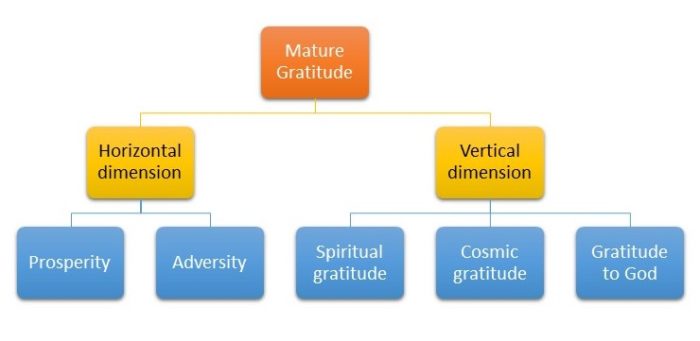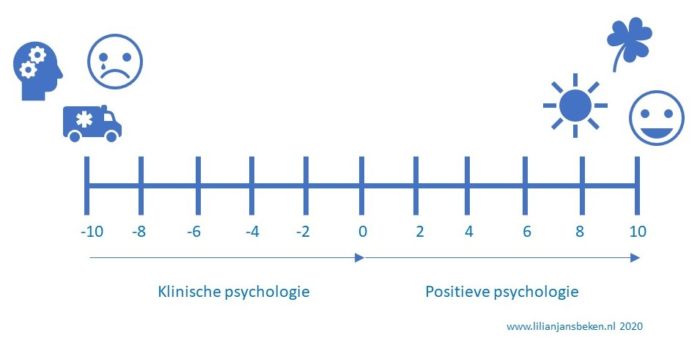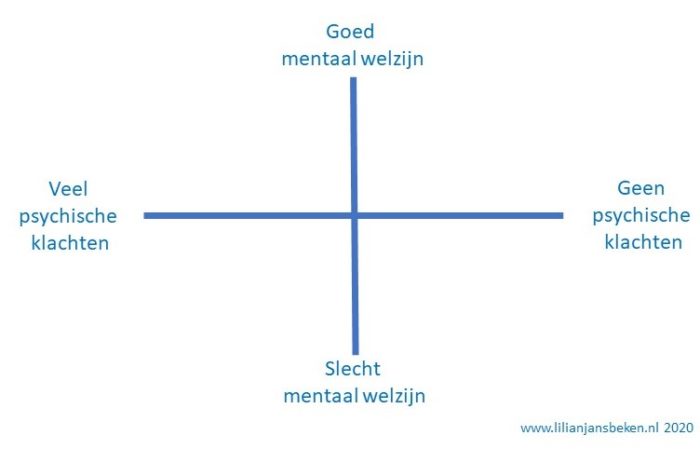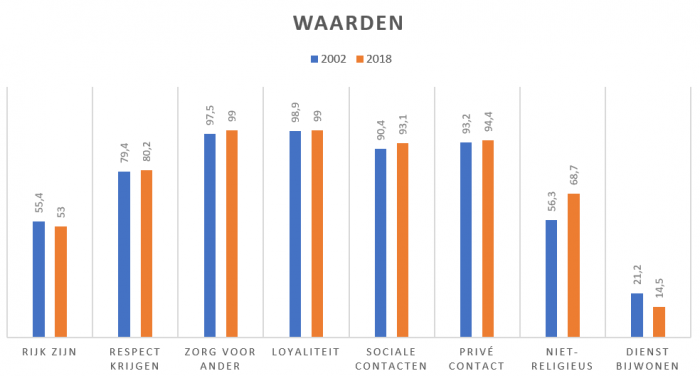A few days ago, a follower sent me a message through LinkedIn: “Ever since I haveread your book Een zoektocht naar dankbaarheid, I see things all around me that I can be grateful for. I never had that before, what a coincidence!” However, this is no coincidence. Psychologists call this the frequency-illusion or the Baader-Meinhof phenomenon. As soon as someone becomes aware of something, the brain tends to notice it more often.
Verder lezen “Grateful for the Baader-Meinhof phenomenon”Gratitude in times of crisis
Gratitude
Gratitude is an emotion that arises when people realize that they have received something from someone else they needed. In this crisis, we see how hard the health care people, among others, are working to manage the influx of critically ill and contagious people, even at the risk of becoming ill themselves. We now collectively realize that our society urgently needs these people and their expertise in caring for ourselves and our loved ones.

Expressing gratitude
Many people in our society would like to express their gratitude. We want to let the other know that their commitment, their sacrifice, is appreciated. For example, last Tuesday in the Netherlands, we massively clapped for our people in healthcare. That is a very creative way to show gratitude. It is in our nature to show our appreciation in a creative way. This also applies to the gardeners who now have beautiful flowers that are not going to the Vatican and that they would otherwise have to throw away. How nice is it if you can make other people happy to show your appreciation for their efforts?
Contagious
How come we suddenly see so much gratitude in our society? Gratitude, like all other emotions, is contagious. When we see someone happy or sad, our mirror neurons ensure that we experience the same emotion. Because someone else expresses gratitude for the people in health care, other people also realize that these people give our society something that we really need. As a result, gratitude spreads like ripples in the water in our society.
Motivation
So, if we feel grateful for someone who has done something for us, we would like to give something back. Gratitude motivates and activates. We want to do something for the person who helped us, but that does not necessarily have to be aimed at this particular person. When we feel gratitude, it is also possible that we want to do something for someone completely different. We see that people in health care work hard and then therefore there are people who want to look after their children. But we also see other initiatives to support people at risk of being ignored, just as the people in health care support our sick.
Continue!
Let’s continue with these great actions! Let gratitude flow through our society through beautiful initiatives for appreciation and support for those people who need it most now. And once again from me, many thanks to everyone who is helping to keep our society running in this time of crisis. If you find stories about gratitude inspiring, my book (in Dutch) can be ordered until April 6 with a discount AND signature through my website www.lilianjansbeken.nl.
Gratitude to God Grant
The John Templeton Foundation granted the Biola University with almost $4,000,000 to further the study of Gratitude to God. The Gratitude to God project intents to employ conceptual and empirical methods to investigate the nature of Gratitude to God and to grasp its differences and relations compared to person-to-person gratitude, and more broadly, to illuminate the nature of a fundamental affective process within the psychology of religion. Dr. Lilian Jans-Beken submitted a letter of intent to this project in collaboration with dr. Paul T.P. Wong, and she received word that she is invited to submit a full proposal to the project.
The research question that is presented in the proposal Mature gratitude based on the transformation of suffering is threefold. First, with the proposed study we want to look further into two dimensions – horizontal and vertical – of mature gratitude. We propose that the vertical dimension includes Gratitude to God. Second, we want to look into the proximal virtues of mature gratitude to determine other virtues important to mature gratitude to cultivate. Third, we want to conduct an experiment to see whether a writing intervention can contribute to cultivating mature gratitude.
We congratulate dr. Lilian Jans-Beken with this succes and wish her all the best with the next submission!
“Patience is a virtue”
Patience
“Be patient!” or “patience is a virtue”. Who has never heard this? But what is patience exactly? Patience during an adversity means being able to wait calmly for a bigger reward in the future than someone would receive at that moment. A patient person tolerates or can bear an unpleasant situation until better times come. This requires self-control and is also referred to as deferred gratification.

Three forms of patience
Three forms of patience are mentioned within psychology. The first form is interpersonal patience. This is a calm reaction to other people that we actually find difficult, unpleasant or frustrating. The second form is patience in case of adversity. This is the calm response to and tolerating serious setbacks in life. Think of having a chronic or life-threatening illness or serious financial problems. The third form is patience for daily frustrations. This is a calm response to daily frustrations such as traffic jams or the long line at the checkout. All three forms of patience mean that people respond to a situation that they consider a setback.
The narrative
Research shows that just having a character strength is not enough to use it effectively. To be able to use a character strength in daily life, such as patience, it is necessary to form a narrative in which experiencing setback acquires meaning or explanation. This means that people tell a story about themselves and what happened to them to shape their identity. In the case of patience, people tell themselves to stay calm by regulating their emotion and attach meaning to the adversity or person they are dealing with.
What does scientific research say?
Although scientific research into patience is still very scarce, a few things are known about the subject. It appears that having patience is related to psychological well-being in the longer term. It also appears that patient people achieve their goals better than impatient people. Patient people accept setbacks and frustrations on their way to their goal. They continue to make more effort and do not drop out. They do something less often at an incorrect or unfavorable moment but are able to wait until the right moment arrives to act.
Three tips
Being patient can help you deal with life more resiliently. Fortunately, you can practice being more patient:
1. Accept that you are impatient. Tell yourself that you understand that you are impatient, but that if you will wait for a while it will all be okay.
2. Be aware of the things you cannot control. By surrendering to such situations or people you feel much calmer.
3. Take a deep breath. By taking a deep breath, you activate the nervous system to calm down and restore your bodily stress reaction. It gives you room to think clearly again.
Good luck with these tips to become more patient and have faith because it will all be alright in the end.
Spirituality and gratitude
As an expert in gratitude, people sometimes ask me if you have to be religious or spiritual to be thankful. This assumption is very understandable because all religions and major worldviews regard gratitude as a core virtue. Research shows that religious or spiritual people report higher levels of dispositional gratitude than people who say they are not spiritual or religious. To answer this question, we need to look at what science says about the origin of people’s spirituality. How did spirituality evolve and how is it associated with gratitude?

Cognitive evolutionary science
One component of the scientific study of spirituality is cognitive evolutionary science. It is an approach that assumes that the mind is not just a blank slate that can have anything written on it but that it is shaped by evolution to have a certain structure that expects a specific type of information coming in. When we look at spiritual thought and behavior from a cognitive evolutionary scientific perspective, we can see how spiritual thought and behavior may be a byproduct of tendencies that evolved for other purposes. This is called the byproduct hypothesis.
Byproduct hypothesis
This byproduct hypothesis considers spiritual thought and behavior a mistake. Humans have cognitive tendencies that evolved for other purposes and they just happened to kick off spiritual belief as a side product. It’s an overfiring of certain cognitive tendencies that we have. It doesn’t seem to have any adaptive function, and it is therefore really puzzling in terms of the payoff structure. But the reason it exists is because of the original cognitive function that pays for itself. The cognitive function evolved because it does some important work in, for instance, in danger perception, but it then overfires and produces spiritual beliefs.
Apophenia
An example of this is called apophenia; the human tendency to connect a subjective experience as something recognizable to a specific meaning to them that is incorrect. This stems from the principles of evolutionary psychology that our minds are not built for accuracy or truth or to provide us with an accurate representation of the world, but they are built for survival. Our brain does all kinds of pre-processing of sensory information that comes into our sensory organs before we have a subjective experience, such that by the time we have that experience, let alone the interpretation of that sensory information, it is already been translated into something that best serves our goals of reproduction and survival.

Costly errors in perception
For survival it is important to see agents when there are actually none, instead of missing agents that are actually there. Evolution would guide the system that is inclined to make the least costly of those two errors. Imagine there is someone walking through a savannah and hears some grass rustle. Now, what is the more costly of the two errors? To assume that that was a predator when there isn’t one? Or to assume that there’s nothing there when it actually was a predator? Clearly, the less dangerous thing is to make the error of over-detection; assuming that there’s something there when there isn’t. The cost of that is that you just unnecessarily engaged the fear response. But the cost of the error of under-detection, where you’re missing the predator that’s actually there, is that you become diner. This is why humans see random agents with minds in nature. We all have seen faces and animals in clouds, stars, food, or photos.

Hyperactive agency detection device
Justin Barrett has called this the hyperactive agency detection device, and he and Stewart Guthrie and others have made the point that this tendency to over-perceive agency likely underlies our tendency to infer gods and spirits in the natural world. Especially in the absence of a scientific explanation for things like the wind and the tides, and the rising of the sun and the moon, the human mind would have immediately inferred supernatural agency behind these natural events. This is, among other theories, why wind spirits and sun gods were born in our pre-history.
Spiritual thinking
Thus, the hyperactive agency detection device is rooted in the byproduct hypothesis. With the byproduct hypothesis, which suggests that spiritual beliefs are the consequences of evolved genetic adaptations that we have for different reasons. They were adaptations that served their own purposes in human survival. But as a byproduct, they lead to spiritual thinking. In other words, our ancestors weren’t selected because they believed in gods. They were selected because they could perceive agency and purpose in an environment that was full of active and plotting minds. The fact that such a system also led them to perceive active and plotting gods was just an accident.
Gratitude for supernatural beings
Now back to gratitude. As we have seen above, humans perceive supernatural gods, spirits, and ancestors in their environment and they mistakenly connect them with the danger or abundance in their life. These gods, spirits, and ancestors are considered to be responsible for adversity or prosperity. Already the prehistoric humans made offers to propitiate gods, spirits, and ancestors. They also made thanks-offerings because they had a good hunt, or they could harvest enough crops to feed their families and tribes. Thanking a supernatural or non-existing being has become part and parcel of the human spiritual dimension, also called the vertical dimension.
Mature gratitude
New research by Jans-Beken and Wong is looking into existential gratitude or mature gratitude. This concept includes both a horizontal and a vertical dimension (see diagram below). The horizontal immanent dimension includes gratitude for prosperity and adversity of the world that is conceived consciously and within earthly borders. It is directed at materialistic and naturalistic things, expected and unexpected events, and the people with whom we interact

Vertical dimension
The vertical transcendental dimension of gratitude can assist in experiencing the horizontal dimension of gratitude. This transcendental dimension is the experience of gratitude for phenomena that cannot be precisely and mentally located in space and time. Illustrations of this vertical gratitude are cosmic gratitude, gratitude to God, or spiritual gratitude that can be elicited by, for example, gratitude for ancestors or spirits, but also an awareness of being part of something big.
Is spirituality necessary?
When talking to people about gratitude in times of adversity, most of them tell about this vertical dimension. Not everybody mentions God explicitly, but most of the people I interviewed for my book talked about the feeling of being part of something bigger than themselves or something between “heaven and earth” that decided it wasn’t their time yet. It seems to be comforting to direct gratitude to something big and kind to cope with suffering. So, is it necessary to be religious or spiritual to experience gratitude? I assume it is possible to feel grateful for earthly things, but a sense of a vertical dimension can deepen, intensify and strengthen the feeling of gratitude. My future research should shed light on this assumption so keep following me!
With great thanks to the EdX course The Science of Religion by The University of British Columbia.
Virtues and character strengths
Weaknesses
People in our environment have the tendency to tell us what our weaknesses are, and what we need to improve ourselves. However, often we already know what our faults are, and such a conversation gives us an unpleasant and uneasy feeling. Science says that it is therefore a good idea to talk about our virtues and character strengths instead of our weaknesses.
Virtues and character strengths
Virtues and character strengths are an expression of personal characteristics or personality that are considered moral goodness. This means that virtues and character strengths help people to do what is good and to avoid what is bad. Living a virtuous life and using your character strengths ensure that your own well-being and that of the people around us improves.
The difference
Peterson and Seligman (2004) have done extensive research into these virtues and character strengths and they distinguish six broad categories of virtues: wisdom, courage, humanity, justice, temperance, and transcendence. The psychological ingredients of these six virtues are the character strengths. These become visible when someone shows certain behavior that others can recognize. For me, that means that other people can also see that I am a grateful person, consider me wise and know that I appreciate beauty.
Benefits
If you know what your strengths are, you can use them more often. People who use their character strengths in daily life feel happier. Paying attention to the character strengths at work also bears fruit. Researchers have discovered that you are more likely to have positive experiences at work if you use at least four of your character strengths. And it is very inspiring and useful to work with children on their character strengths. Children say that they feel happier and more resilient, and parents tell that the parent-child relationship has been strengthened because of their awareness of character strengths.

Get started
You can fill out the Values in Action Strengths Inventory yourself and discover your own character strengths. This questionnaire has 120 statements and at the end you will see your strengths and weaknesses. Are you a coach or do you want to work with character strengths in your own? Then the card game of which you see several cards above, these are in Dutch but also in Englis available, is highly recommended! This card game can be purchased via Amazon. There is also a worldwide Virtues project. This is an international initiative to apply virtues and character strengths, such as honesty, patience and respect, in daily life. Please, leave your character strengths in a comment below and share your experiences with character strengths with us!
What is mental health?
Clinical psychology
Initially, mental health was presented as a horizontal axis, such as the figure below. Having psychological complaints is completely on the left with the negative numbers. The more problems with psychological complaints, the lower the number. Clinical psychology focuses on therapies and programs to reduce or eliminate psychological symptoms. If there are no more complaints, the person has a score of around zero and the work of the clinical psychologist is done. But a zero is not really good, it is at best average.

Positive psychology
Positive psychology then developed which is concerned with increasing the score from zero to ten. A ten means that there is good mental well-being. There are no psychological symptoms and the person feels happy, joyful and satisfied. To get from zero to ten, positive psychology makes use of all kinds of positive psychological exercises such as the gratitude diary, the three-good-things exercise, the-best-possible-self exercise or mindfulness training. One of the goals is to get as close to ten as possible so that if life is taking a bad turn, someone will not fall directly below zero but will be resilient enough to cope with the setback.
The reality
This way of thinking about mental health was very straightforward and it didn’t seem to fit well into reality. After all, it is possible that someone with depressive symptoms who feels connected to his family attributes himself a better quality-of-life than someone who is lonely in life. Or someone with a psychosis who looks at life optimistically may be better able to deal with the psychological symptoms than someone who is more depressed and pessimistic. Psychological complaints and mental well-being influence each other but are different things.

Two-continua model of mental health
For that reason, the American psychologist Corey Keyes cut the above axis in two and made it into a model with two axes: the two-continua model of mental health. The psychological symptoms, whether or not present, are plotted on the horizontal axis and the mental wellbeing, whether or not present, is displayed on the vertical axis. By psychological complaints we mean disorders such as depression, anxiety, psychoses, compulsive thoughts or post-traumatic stress. Mental well-being includes characteristics such as optimism, positive feelings, sense of purpose, social connectedness and gratitude. For someone with the same degree of psychological symptoms, mental well-being can be crucial for their perception of quality-of-life.

Research
Research has indeed shown that the two-continua model of mental health is well applicable in the world of everyday life. One of my research was into gratitude, mental well-being and psychological complaints over a period of thirty weeks. From this study it became clear that gratitude does not immediately reduce psychological complaints on the long run, but that gratitude is related to better mental well-being. Improved mental well-being was then associated with fewer psychological symptoms over time.
Conclusion
This insight into mental health shows that we need the care and knowledge of clinical psychology to score as well as possible on the axis of psychological complaints; the less psychological complaints the better. Positive psychology, preferably with the approach of positive psychology 2.0, has the knowledge and insights to improve mental well-being. Together they can help find a good balance on the two-continua model of mental health and thus support people in their thriving.
Sources:
– Jans-Beken, L. G. P. J. (2019). The Dialectic Dynamics Between Trait Gratitude Subjective Well-Being and Psychopathology Across 30 Weeks. Counselling Psychology Quarterly. https://doi.org/10.1080/09515070.2019.1638228
– Keyes, C. L. (2005). Mental illness and/or mental health? Investigating axioms of the complete state model of health. Journal of Consulting and Clinical Psychology, 73(3), 539–548. https://doi.org/10.1037/0022-006X.73.3.539
Five Insights on Gratitude
Mark Travers PhD distilled five insights about gratitude and health and published them on Psychology Today:

- Gratitude facilitates social well-being
- Gratitude is associated with higher levels of social well-being
- Grateful people are less likely to exhibit psychopathology
- Not all gratitude interventions are successful
- Gratitude may have modest beneficial effects on physical health and bodily functions
We thank Mark Travers for putting our research in the spotlight! You can read the full Psychology Today blogpost on their website.
Are we still grateful?
In research, it is not common to ask people bluntly whether they feel individualistic or selfish. But other human values and characteristics are known to be related to gratitude, individualism, and selfishness. For example, gratitude cannot go together with materialism, gratitude lets us focus on the other, and religious people are more grateful. Perhaps we can find an answer about the current degree of selfishness and individualism, and whether we are still grateful, by focusing on these other values and characteristics.

Egoism
I started my search for an answer on the website of the European Social Survey (ESS). The ESS is a cross-cultural study that is conducted annually in around 20 European countries. They make their data publicly available and it is possible to perform all kinds of analyses directly in the browser. I was able to compare the years 2002 and 2018 with the help of the data. The questionnaire asks the more than 30,000 participants questions about their values such as power, kindness, social contacts and religion. It is known that these values are related to gratitude, but that they can also be an indication of selfishness.
Power
Power is wanting to impose your will on other people, even against their wishes or interests. Gratitude and power have an interesting relationship. Powerful people who feel attacked are more likely to denigrate the other. As soon as the other person expresses gratitude, the powerful person is less inclined to be denigrative. Also, expressing gratitude is seen as paying respect for someone else. And already mentioned, materialism and gratitude do not go together. It is almost impossible to want more stuff and at the same time to be grateful for what you already have. Valuing power could therefore hinder the experience of gratitude.
When asked whether it is important to be rich, and to have money and expensive things, 53% of Dutch people said that this is a little to very important for them. This percentage was 55.4% in 2002 and has therefore remained virtually unchanged in the last 16 years. There were differences in gender and age. Apparently, women and the elderly attach value this more than men and young people. People were also asked whether it is important to receive respect from others. In 2002, 79.4% of the Dutch participants thought that was important, and in 2018 it was 80.2%. Older people believe that receiving respect is more important than young people. Being rich therefore seems to be less crucial than getting respect.
Kindness
In an individualistic society, there is thought to be less kindness. Gratitude is a social emotion that plays a central role in relationships. Kindness and gratitude are related, because expressing gratitude motivates the kindness of the benefactor. Also, it encourages the kindness of the receiving person to do something kind to someone other than the benefactor. In addition, gratitude creates a social bond between people and loyalty for family and friends. Gratitude goes hand in hand with a persistent thought of wanting to give back something kind for a favor received, now or in the future. Gratitude and kindness therefore seem to be mutually dependent.
Of the Dutch participants in the ESS, no fewer than 97.5% in 2002 and 99% in 2018 indicated that it is important to help others and to take care of others. Men consider this to be of greater value than women in both 2002 and 2018. Young people consider this more important than the elderly in 2002, but this difference disappeared in 2018. The percentages are also high for loyalty to friends and commitment to loved ones. In 2002, 98.9% of the participants indicated that this was important and in 2018 this was 99%. In both 2002 and 2018, men scored higher than women. In 2002 there is no difference in age, but in 2018 that was the case; the elderly consider loyalty to friends and commitment to loved ones more important than the young. Kindness as a value still seems to be alive and well in the Netherlands.
Social contacts
The ESS questionnaire also asked several questions about social contacts. For example, they asked the participants how often they had contact with friends, family and colleagues. In 2002, 90.4% of Dutch people said they had social contact with friends, family and colleagues at least once a month; in 2018 that was 93.1%. Young people and women have more social contacts than older people and men. Most of the Dutch people have at least one person to discuss personal and intimate topics with. In 2002 it was 93.2% and in 2018 it was 94.4%. The elderly and women have more people to share their concerns with than young people and men. Regular contact with other people seems to be the norm among the Dutch participants.
Religion
Gratitude and religion are inextricably linked. Gratitude plays a central role in all philosophies of life and is regularly mentioned in texts and services. In the Netherlands, we saw a decrease in the number of people who consider themselves to be religious for years. The ESS also asks about the religiosity of the participants. In 2002, 56.3% of the Dutch population indicated that they did not belong to a religion. Only 21.2% of those who do believe went to a service at least once a month outside of the special religious days such as Christmas or Eid. In 2018, the percentage of non-religious Dutch had already risen to 68.7%. Of the people who said they are religious, only 14.5% go to a service outside the special religious days. With the disappearance of religion and the religious community, a place where gratitude is mentioned on a regular basis disappears.

Individualism
The Central Bureau of Statistics of the Netherlands has conducted research into the individualization of their country. Individualization has three main parts. The first part is the influence of social and social institutions such as church and marriage. The second part is the freedom of choice and self-determination of the people within a community. The third part, the bond between the individual and different groups in the community is important.
Institutions
The figures from the EES already showed that the influence of religion and the church has virtually disappeared from the Netherlands. People are less religious and of the people who do believe, only a small group go to a prayer house. Marriage too loses its self-evidence. Fewer and fewer people are getting married and the number of people living alone has never been so high in 2016 with 38%. The obvious connections with others seems to be slowly disappearing from our society.
Freedom of choice
More common is the growing emphasis on being unique. This is reflected, for example, in the first names of children. More and more children have unique and sometimes self-invented names in the Netherlands. Another development regarding wanting to be unique is the increase in piercings and tattoos in the Netherlands. By applying decorations to the body, people want to distinguish themselves from others. And in the past, marriage used to be an economic entity in which you did everything together. Nowadays, we want both partners to be financially independent. We value it when people want to be autonomous and unique.
Social connections
We have already seen that most people in the Netherlands have regular contact with others. People are also often members of associations; about three-quarters of the Dutch are members of some association or club. Nowadays, contact is not only taking place in real life, but social interaction also takes place via the internet. Dating over the internet is extremely popular and the internet is ranked fourth as a place to find a romantic partner. Only 2% of the cohabiting couples had met on the internet in 2003, in 2008 this was 10% and in 2013 already 13%. People still have many social contacts and digitization has added a new dimension.
More selfishness and individualism?
So, can we say there is now more selfishness and individualism than in the past? The values associated with selfishness and gratitude do not seem to have changed over the last 16 years. Encouragingly, high percentages are related to kindness. We apparently still have an eye for the other. Due to the digitization and the disappearance of institutions that ensured solidarity and engagement, there seems to have been more emphasis on independence and being unique. On the other hand, we see that the Dutch still have many contacts, but we are increasingly less part of a large demarcated group within society. Because of this, people feel that they are being thrown back on themselves and are trying to take care alone. Fortunately, I cannot conclude that there is more selfishness, but there seems to be an increasing emphasis on the individual who has to find a new way to be connected to others.
Conclusion
Are we still grateful? That was the question with which this article started. There are several points that stand out in the foregoing. People still find it important to pay attention to other people and most people also have a lot of contact with others. So, there are enough options to express and receive gratitude. On the other hand, an important place has disappeared where gratitude played a central role: the church. Because of this, the word “gratitude” may have disappeared from our daily lives. And if you barely or ever get in touch with the term, you do not know enough what it means and that in turn does not motivate you to be grateful.
I therefore think that we must first make a distinction between being grateful, being ingrateful and being ungrateful. Being ungrateful means that someone has the feeling that they are entitled to something. Being grateful is the realization that someone has given or done something valuable. Being ingrateful arises if you do not know that gratitude exists, how it feels and how you can express it. I think that people are increasingly ingrateful because they do know little about gratitude. They simply do not encounter it enough. As soon as we ensure that people’s eye falls on gratitude, more people will be able to be thankful again. Let’s get started!
Gratitude is a positive emotion
Negative emotions
Anxious, furious, angry, insecure. These are negative emotions that people experience when faced with danger or setback in their lives. These emotions narrow the attention to the threatening situation. It motivates someone to face the situation or to run away. Therefore, negative emotions ensure that we can deal with problems in life in a proper way. It is clear why humans developed negative emotions during evolution; they helped to survive in a dangerous environment.

Positive emotions
Grateful, happy, surprised, happy. These are some of the positive emotions that people can experience. Apparently, these emotions have been useful also during evolution, otherwise they would have disappeared over time. People experience positive emotions in times of peace and abundance. These emotions cause people to broaden their attention on everything and everyone around us. As a result, they develop skills that will come in handy later when they are in danger. This is called the broaden-and-build theory.
Broaden-and-build theory
In ancient times, when humans were living in caves, positive emotions were also very important. Because of these positive emotions, people started exploring the environment, experimenting with materials, and making contact with other people. This gave them a map in their head with hiding places and food sources. They discovered how they could make leather and protect themselves against the rain and cold. Contact with other people promoted the ability to collaborate and increase the chance of survival in the event of acute danger.
Gratitude
Gratitude is a positive emotion that also proved to be useful. Gratitude creates social bonds with other people which can come in handy in the future. Someone wants to “repay” his benefactor if the opportunity arises. By keeping this in mind, the other remains in the picture. These social relationships are very important to work together, and to cope with the difficulties in life.
Another skill that develops through gratitude is creativity. If someone wants to pay something back, it is not simply giving back the same as what was received. That would be called borrowing. No, someone wants to give something back that the other person needs. So, creativity is needed to get as original as possible. Creativity can later help to approach and solve setbacks in a different way.
Useful emotions
In my opinion, the words “negative” and “positive” are not very well chosen for practice. Negative emotions are important tools in certain situations, and positive emotions can be negative in other situations. Of course, negative emotions are not pleasant to feel, but they do motivate action to solve a problem. And if someone is dealing with an unpleasant or sad situation, then joy or enthusiasm can be awkward. It is therefore important for science to distinguish between negative and positive emotions, but let’s consider all emotions useful in daily practice.
Sharing this post is highly appreciated!











